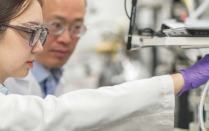Virial Equation of State as a New Frontier for Computational Chemistry

Images from calculations of virial coefficients for ammonia and carbon dioxide.
Published December 29, 2022
SUNY Distinguished Professor David A. Kofke has recently published a Perspective article for the Journal of Chemical Physics that presents an overview of recent advances in thermodynamic modeling via calculation of virial coefficients, and suggests areas of focus for further progress. The article titled “The virial equation of state (VEOS) as a new frontier for computational chemistry”, discusses the renewed interest in the VEOS due to advances in theory, algorithms, computing power, and quality of molecular models. With the emergence of increasingly accurate first-principles computational chemistry methods, and machine-learning techniques to generate potential-energy surfaces from them, VEOS is poised to play a larger role in modeling and computing properties. Recent applications have shown that for simple molecules, VEOS can provide first-principles supercritical thermodynamic property data that are competitive in quality with experiment. Moreover, VEOS provides a focused and actionable test of molecular models and first-principles calculations via comparison to experiment.


